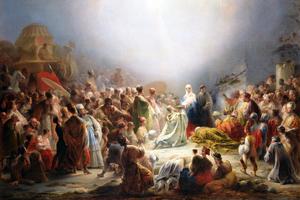Jesus Heals Our Blindness So We Can See the Unseen
How many people in our lives simply ‘blend into the landscape?’

Chapter 3 of the Acts of the Apostles contains Peter’s preaching about Christ as healer from sin and its effects as a consequence of his passion, death and resurrection. The sermon was occasioned by Peter’s healing, in Jesus’ name, of a cripple.
Acts tells us that the man had a lifelong disability. He also had at least someone to demonstrate mercy toward him: he “was carried and placed at the gate of the temple called ‘the Beautiful Gate’ every day to beg for alms” (3:2). In that sense, he had become part of the area’s “landscape.” He occupied a niche in the daily layout of things.
The man’s in place in his begging venue when he and Peter meet, an encounter that turns out quite differently from the man’s expectations. Just as the paralyzed man whose friends drop him in on Jesus through the roof is first given forgiveness of sins rather than healing of limbs (Mark 2:1-5), so the cripple at the Beautiful Gate set his eyes on the Galilean fisherman in the hope of a coin or two.
God’s hope, of course, surpasses humans’, which is why the man receives through Peter something more valuable than his mite. And having raised him by the hand to accompany him and John to afternoon prayer at the Temple — to be like that one in 10 lepers who voices gratitude (Luke 17:15-19) — his very public healing in a very public place assembles a public to whom Peter preaches.
How much that man might have otherwise been explicitly noticed in that niche is another question. There’s an older man with a cardboard sign soliciting donations who walks the median strip on Route 50 and Annadale Road here in Virginia on Saturdays. He’s part of the “landscape,” though how much many people know of him is debatable.
There were others less well-known in the Bible. Jesus encountered (John 9:1-41) a man blind from birth, whom he healed by sending him to wash in the Pool of Siloam. When he comes back on his own — unlike the accompanied cripple of the Beautiful Gate — the crowd is divided. “Isn’t this the man that used to sit and beg?” Some said yes, some said no, still others just thought he looked like him. Those unkempt, smelly beggars all look alike anyway.
John notes (9:8) that that crowd divided over whether or not this man is the man born blind included his “neighbors” (γείτονες). Γείτονες are supposed to be people with whom you share good news, like finding your lost drachma or your lost sheep (Luke 15: 9, 6). But if the blind man’s neighbors weren’t sure if he was their neighbor, were they so far from the contemporary “neighbor” of anonymous identity whose presence is only randomly encountered in the hallway? He was noticed as part of the landscape, but not as a distinct person.
At least he had a neighbor. The paralytic Jesus healed at least had men to haul him around. The blind man at least had some neighbors to quibble over whether they recognized him. Consider the sick man at the Temple’s Sheep Gate (John 5:1-15) who had been for years outrun to the Pool of Bethesda by others, abandoned in his illness. He had so blended into the landscape that he elicited no care or mercy, the consummate example of familiarity breeding contempt, at least by omission.
How many people in our lives “blend into the landscape?” They’re noticed enough that their absence gives us the feeling, “something’s missing.” But they’re not noticed enough to make us think “someone’s missing.”
It’s said that loneliness is a cancer of our time, but loneliness often begins with anonymity. It’s true of the beggar on Route 50. It’s true of the unborn child who’s “out of sight and out of mind.” It’s true of the handicapped person from whom we avert our eyes.
Being a neighbor is not a function of proximity. In the Parable of the Good Samaritan (Luke 10:25-37), the first two candidates for “neighbor” — the priest and the Levite — are not so much removed bystanders as by-passers. They embody the charity-bereft “faith” James (2:14-19) excoriates when he speaks of wishing the brother “be well and stay warm” with no concrete follow-up.
That action also largely has to occur in this life. One of the scenes in Dickens’ A Christmas Carol — a scene frequently prone to ending up on the cutting room floor in film adaptations — is the episode when Marley leaves Scrooge. In the book, he exits through the room in Scrooge’s window to join a chorus of damned spirits:
The air was filled with phantoms, wandering hither and thither in restless haste. … Many had been personally known to Scrooge in their lives. He had been quite familiar with one old ghost, in a white waistcoat, with a monstrous iron safe attached to its ankle, who cried piteously at being unable to assist a wretched woman with an infant, whom it saw below, upon a door-step. The misery with them all was, clearly, that they sought to interfere, for good, in human matters, and had lost the power forever.
That old ghost may have been proximate, but now he is also impotent. It’s not coincidental that the Last Judgment is also an examination of whom one noticed or didn’t (Matthew 25:31-46).
The healing of the man born blind in John 9 is part of a larger polemic over being physically versus morally blind, being impeded from seeing versus refusing to see what is before one’s eyes. How often does that merge with “not noticing” the unnoticed?
- Keywords:
- charity
- acts of charity
- healing
- jesus christ














